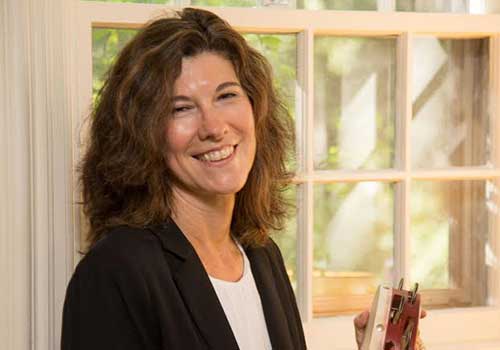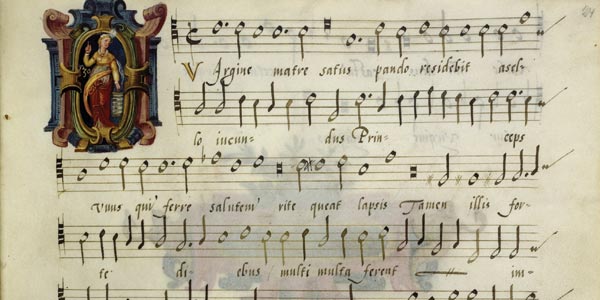Life of the Mind
Living Life Harmonically
Musicology and esoteric studies intersect for one music history scholar
by Marjorie Roth
I think of musicologists as thrice-blessed among academics. Our field is naturally interdisciplinary, requiring skill in music, in history, and in pedagogy. Nobody is born knowing they’ll be a musicologist; it’s the kind of career one grows into gradually. We start as performers, usually, and perhaps consider music education or music therapy as a profession along the way. But in the end we realize that for us the true sympathetic vibration is felt when we contemplate the art of music as part of the History of Ideas. Nearly all musicologists continue to make music informally, and of course teaching is the public face of what we do professionally. But underneath all that, the musicologist is a seething cauldron of sounds, stories, and ideas that reflect his or her individual understanding of how music functions as an interface between our world of art and the world outside it. Music touches almost every aspect of human life, and so the possibilities for the researcher are, truly, endless. That means, though, that investigating a particularly broad music-historical question can cause us to muck around in the databases of disciplines very far removed from our own; and that takes courage and care. Interdisciplinarity is risky business.
Discovering esoteric studies
My most recently completed research project is a case in point. I was faced with the challenge of situating a rather unusual 16th-century composition within the musical culture of Renaissance Europe. Orlando di Lasso’s motet cycle Prophetiae Sibyllarum (The Prophecies of the Sibyls) is a puzzling work. It breaks all contemporary rules of harmony, has no reception history, features pagan prophetesses in what is assumed to be a piece of Christian liturgical music, and has a text so obscure that there was no known occasion upon which it might have been performed. Yet the illuminated manuscript of the only existing copy of the work is so opulent, and the music is so lush, that the cycle must certainly have been important for someone during the composer’s lifetime. Moreover, its uniqueness suggests that it was commissioned for a very specific purpose. Traditional research methods in musicology were simply inadequate to address all these mysteries, so I found myself reading widely in art history, salvation history, Renaissance literature and drama, the history of philosophy, and 16th-century church reform. I also teamed up with a specialist in Renaissance Tuscan poetry at Yale, Dr. Amerigo Fabbri, who translated the texts into English for our forthcoming joint publication*.
But perhaps most important for my career is the fact that Lasso’s Sibyls led me to the relatively new field of esoteric studies. A discipline that codifies and sanctions various strains of “rejected knowledge” as valid topics for historical research, esoteric studies has become a refuge for scholars from all disciplines, worldwide, who encounter the influence of alchemy, magic, Hermetism, astrology, or Kabbalah in their work, but experience a dearth of resources on those topics within their established fields. Discovering esoteric studies was, for me, a watershed moment. Study of alchemy within the culture of Italian Renaissance humanism allowed me to see the Sibyls and their prophecies as a metaphor of alchemical transmutation. This, in turn, explained Lasso’s transformational chromatic harmony; it was an imitation of the soul’s transformation through prophecy and revelation. Becoming familiar with the popes and princes in Lasso’s circle who practiced physical or spiritual alchemy was helpful, too, since it allowed me to posit a viable date of composition, identify likely patrons, establish a performance context, and fine-tune the generic designation of the cycle. Time will tell whether the more speculative details of my research will stand. But at the very least, I have reinvigorated the historical investigation of a lovely piece of music, and contributed to the ongoing dialogue about music’s power to embody, reflect, and transform the culture that produces it. And that’s not just a fine and frozen point of “history.” It’s something that speaks directly to human engagement in the Arts today.
The Tarantella
Alchemy figures prominently in a new project I’m preparing for publication, too—an essay that began as a conference paper, titled “Once Bitten, Forever ‘Re-Bitten’: The Tarantella as Music, Medicine, and Magic in Magna Graecia and Today.” Eventually it will serve as the basis of an upper level course on Music, Magic, and Medicine I hope to create with input from colleagues in psychology, biology, sociology, women’s studies, music therapy, dance therapy, and art therapy programs.
During the early modern period, the Tarantella was not merely a social dance, mandatory at Italian weddings, as it is today. It was instead a purgative healing experience involving melody, harmony, rhythm, movement, and color. The afflicted person, usually a peasant woman, having been “bitten” by a “spider,” would fall into a kind of twitching trance that could only be penetrated by music. This kind of illness was so prevalent during harvest season that Tarantella bands were paid by local governments to patrol the perimeters of the fields, in case anyone dropped and needed emergency musical treatment. The victim was taken home and surrounded by a circle of family and friends, into which the instrumentalists would enter one by one until the correct, healing tone color was identified by the victim’s positive response. The same kind of “diagnosis” happened in terms of rhythmic figures and colored scarves. The idea was that the first step toward cure involved helping the victim—who identified completely with her spider at this point— discover which sounds, colors, and meters her spider preferred. Once that was accomplished, the band combined those things into a kind of musical medicine, which they administered repeatedly, sometimes playing for days on end, while the victim “danced” the poison out of her system. In most cases, of course, there was no “bite,” there was no “spider.” But there was some serious irritation, be it social, psychological, sexual, economic, spiritual, or some combination of those things. And music was the answer, the antidote.
It’s easy to see how the Tarantella might serve as a hub for interdisciplinary exchange in the areas already mentioned. And of course scholars with a classical bent will revel in the unmistakable echoes of Dionysian ritual in this modern practice. Once again, this is not just music “history.” After a bit of a slump in the mid-20th century, the Tarantella is back; “Tarantourism” has revitalized the economy of the Salento, the region encompassing the extreme “heel” of Italy’s “boot.” Every summer, thousands make a pilgrimage there to participate in La notte della Taranta. Described exoterically, it’s just a big music festival. But experienced esoterically, it’s much more than that. Attendees bring their tambourines and come not just to listen but to join with the music, to dissolve into it, and to re-emerge as something new. They beat their drums until their hands bleed, and dance until they are free, clear, and empty of whatever ailed them. That’s alchemy. And for me, as a scholar, it’s also interdisciplinarity. I’d be very much in favor of opening the dialogue here at Nazareth with a field trip to southern Italy.
Marjorie Roth, Ph.D., D.M.A., is professor of music history and flute and director of the honors program at Nazareth.
*Updates:
- Roth's research on Orlando di Lasso’s motet cycle Prophetiae Sibyllarum is being published in 2017.
- Roth's work on the Tarantella continues and led to participating in a Tarantella dance and drumming workshop in Hawaii in 2017 with world-famous dance and drumming teacher Alessandra Belloni. In spring 2018, Roth will give an extended version of her Tarantella research as a paper at the Sivananda Yoga Retreat in the Bahamas, where she will also teach a dance workshop.

Marjorie Roth, Ph.D., D.M.A.

Sibylla Persica, Prophetiae Sibyllarum, manuscript
For more on the music department, visit naz.edu/music.